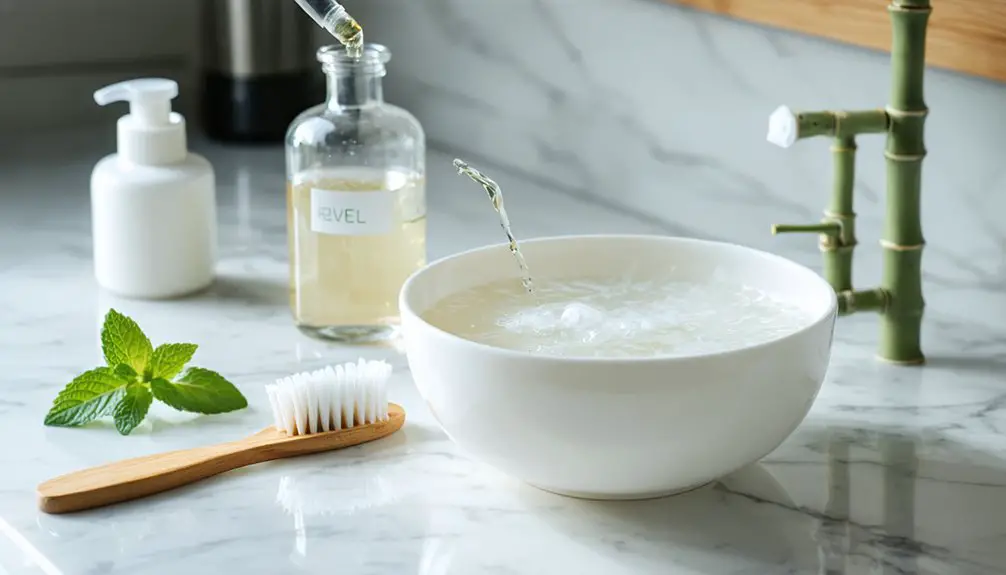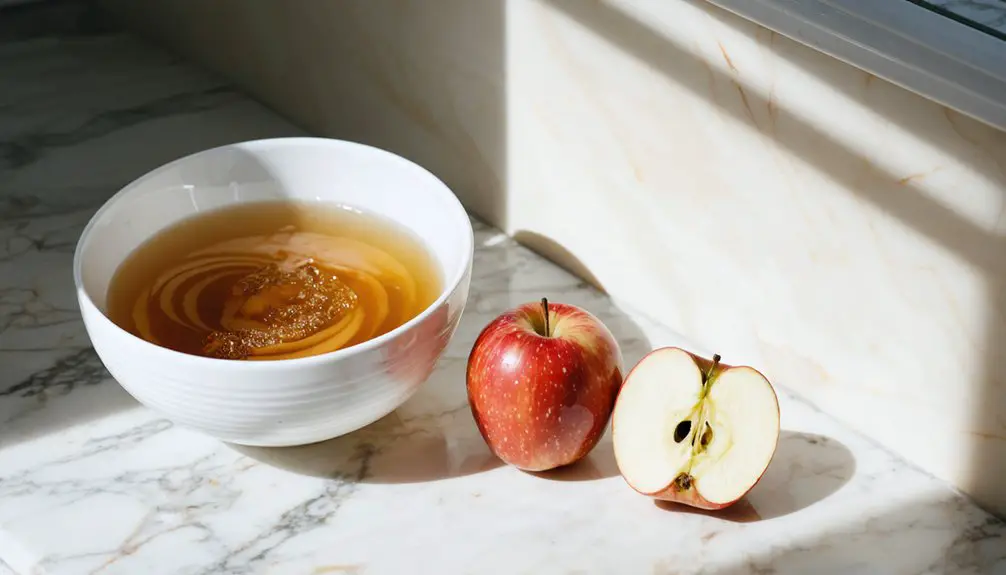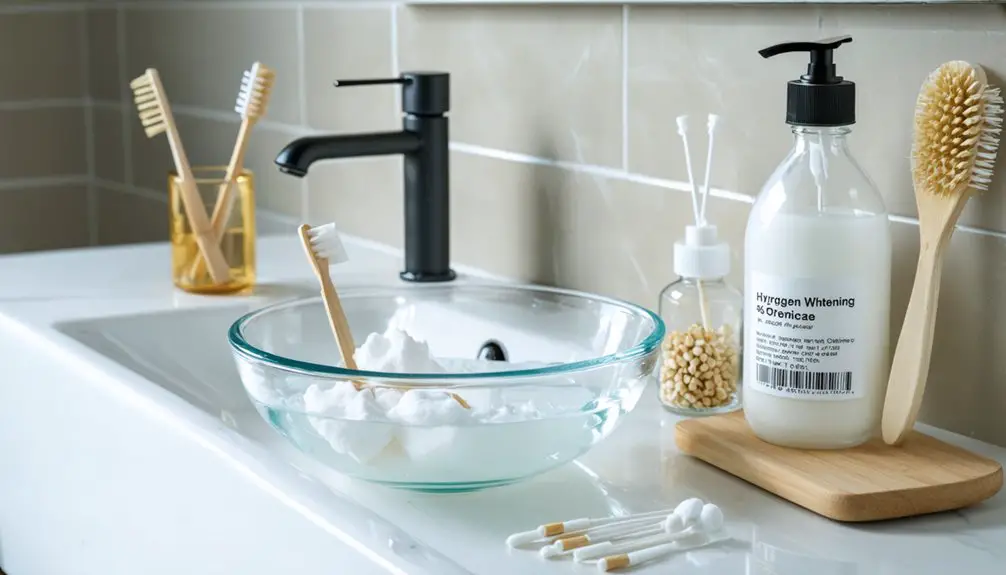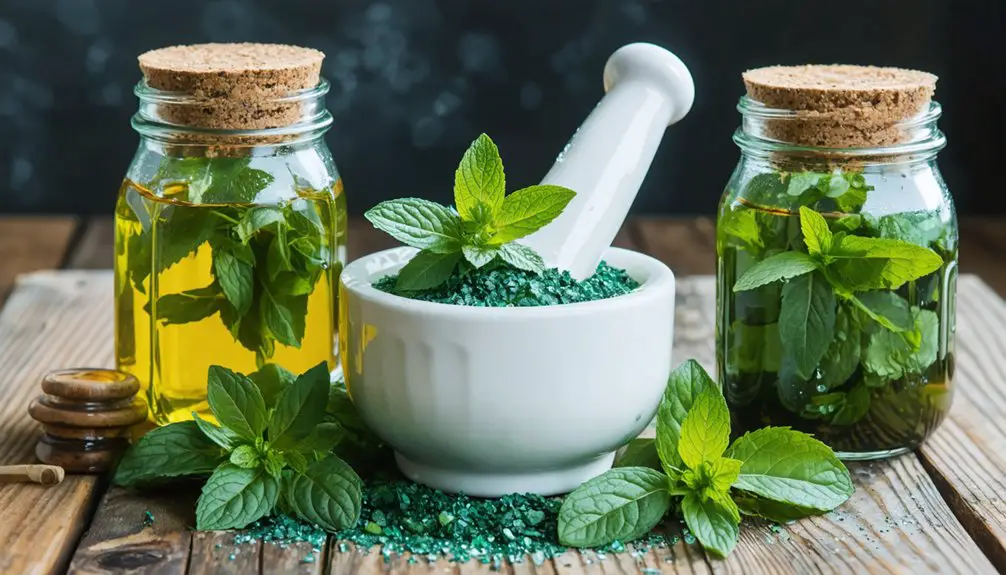While apple cider vinegar can help brighten your smile through its acetic acid content, you’ll need to use it carefully to protect your tooth enamel. Always dilute one tablespoon in a full glass of water, use a straw to minimize contact with teeth, and limit applications to 2-3 times weekly. Rinse immediately after use and wait 60 minutes before brushing. Understanding proper techniques and potential risks will help you achieve ideal results safely.
Key Takeaways
- Dilute one tablespoon of apple cider vinegar in water and use a straw to minimize direct contact with teeth.
- Rinse mouth immediately with plain water after ACV use and wait 60 minutes before brushing teeth.
- Limit ACV teeth whitening applications to 2-3 times weekly to prevent enamel damage.
- Monitor for warning signs like white spots, sensitivity, or discoloration that indicate potential enamel erosion.
- Consider safer natural alternatives like coconut oil pulling or professional whitening treatments recommended by dentists.
The Science Behind ACV’s Whitening Power
While apple cider vinegar’s whitening effects have captured public interest, its mechanism relies primarily on acetic acid’s interaction with tooth surfaces. When you apply ACV to your teeth, its chemical composition works to break down surface stains, creating a temporary brightening effect similar to that of hydrogen peroxide.
However, you’ll need to understand that this whitening action comes at a considerable cost. The same acidic properties responsible for stain removal can trigger serious enamel erosion, potentially exposing the yellowish dentin beneath. With a pH of 2.5-3.0, apple cider vinegar’s highly acidic nature makes it particularly damaging to dental surfaces. Regular dental visits are essential to monitor any enamel damage from ACV use.
Research shows that even diluted ACV considerably decreases enamel hardness, compromising your tooth structure. While ACV does demonstrate some antimicrobial benefits that may help reduce plaque-related staining, its whitening capabilities remain less predictable and potentially more harmful than conventional whitening methods.
Understanding Enamel Health and ACV Effects
Before considering apple cider vinegar for tooth whitening, you must understand how its acidity directly impacts your tooth enamel.
Your teeth’s protective layer begins to weaken at pH 5.5, but ACV’s pH of 2.5-3.0 makes it considerably more acidic than this threshold. This acidity can trigger severe enamel erosion, leading to irreversible damage.
When ACV contacts your teeth, its acid impact opens enamel pores and demineralizes the surface, potentially causing up to 20% enamel loss. The antimicrobial properties of ACV don’t outweigh its potential for dental damage. Studies show that four hours of exposure to vinegar can result in significant mineral loss from tooth enamel.
You’ll notice increased sensitivity to temperature changes, and your teeth may appear yellower or more translucent as the enamel thins.
This structural change isn’t just cosmetic – it makes your teeth more vulnerable to decay and cavities by compromising their protective barrier.
Safe Methods for Using ACV on Teeth
Although apple cider vinegar presents risks to dental health, you can minimize potential damage through careful application methods and proper dilution techniques.
To maximize ACV benefits while ensuring enamel protection, dilute one tablespoon of ACV in a large glass of water. Use a straw to minimize direct contact with your teeth, and never swish or hold the solution in your mouth. The acetic acid in apple cider vinegar can gradually erode tooth enamel with prolonged exposure. Regular use without proper precautions can lead to increased tooth sensitivity and enamel damage.
Wait at least 60 minutes after ACV use before brushing your teeth, and always rinse with plain water immediately after consumption.
For ideal safety, limit your ACV application frequency and avoid combining it with other acidic substances or whitening products. Consider consulting your dentist before incorporating ACV into your oral care routine, as they can provide personalized guidance based on your dental health status.
Warning Signs of Dental Damage
Five critical warning signs can alert you to dental damage from improper ACV use or other acidic substances.
If you notice white spots, dark discoloration, or sensitivity to temperature, you’re likely experiencing enamel erosion or tooth decay.
Don’t ignore persistent bad breath or unpleasant tastes that won’t go away with normal dental hygiene practices, as they often indicate bacterial infection. A foul-smelling compound is released when bacteria consume decaying material. Regular brushing and flossing helps prevent bacteria buildup and bad breath from developing.
- Sharp pain when eating hot, cold, or sweet foods suggests compromised enamel or exposed dentin.
- Swollen, bleeding gums point to potential gum disease or spreading infection.
- Visible pits, holes, or cracks indicate advanced decay requiring immediate attention.
- Loose teeth or unexplained swelling may signal severe structural damage from acid exposure.
Natural Alternatives for Teeth Whitening
When seeking natural alternatives to chemical teeth whitening treatments, you’ll find several evidence-based options that can effectively brighten your smile while minimizing potential enamel damage.
Among natural ingredients, coconut oil pulling offers a gentle approach, reducing bacteria without risking enamel erosion. Studies show that hydrogen peroxide solutions can effectively whiten teeth when used properly as a natural bleaching agent. You can also try baking soda or activated charcoal, but limit use to twice weekly to protect your teeth. The high acidity of apple cider vinegar makes it too risky for tooth whitening.
For dietary approaches, incorporate crunchy fruits and vegetables like apples and carrots, which naturally scrub away surface stains. Boost your calcium intake to strengthen enamel, and increase fiber-rich foods to stimulate saliva production.
Remember to dilute acidic substances and rinse thoroughly after application. While natural methods work more gradually than chemical treatments, they’re generally safer for long-term use when applied correctly.
Maintaining Oral Health While Using ACV
While natural teeth whitening methods can be gentle on your enamel, apple cider vinegar requires specific precautions to protect your oral health.
Though ACV benefits include antimicrobial properties that may reduce plaque and bad breath, its highly acidic nature can irreversibly damage your tooth enamel. To maintain both enamel protection and receive ACV’s oral care advantages, you’ll need to follow strict usage guidelines.
- Always dilute ACV with water and use a straw to minimize direct contact with teeth
- Rinse your mouth thoroughly with plain water immediately after ACV exposure
- Wait at least 30 minutes before brushing to allow your enamel to re-harden
- Schedule regular dental check-ups to monitor your enamel’s condition if you’re incorporating ACV into your oral care routine
Combining ACV With Other Dental Care Practices

When using apple cider vinegar for dental care, you’ll need to dilute it with water in a 1:3 ratio to protect your enamel from acid erosion.
You should wait at least 60 minutes after applying ACV before brushing your teeth to allow your mouth’s pH levels to normalize.
For best results, you’ll want to use a soft-bristled toothbrush and rinse thoroughly with water after each ACV application to minimize enamel exposure to acids.
Safe Dilution Methods
Since apple cider vinegar’s acidic properties can damage tooth enamel, proper dilution methods and complementary dental practices are vital for safe usage.
When incorporating ACV into your dental care routine, you’ll need to follow specific dilution techniques and vinegar ratios to protect your teeth. The standard approach requires mixing 1 tablespoon of ACV with 8 ounces of water, or alternatively, using a 1:5 ratio of vinegar to water. Stir the mixture thoroughly for at least one minute to guarantee even distribution.
- Use a straw to minimize direct contact between the solution and your teeth
- Wait 30 minutes after ACV consumption before brushing your teeth
- Rinse your mouth thoroughly with plain water immediately after use
- Consider ACV supplements in pill form to bypass tooth contact entirely
Timing Your ACV Routine
Proper timing of your apple cider vinegar routine plays an essential role in protecting your dental health.
To maximize enamel protection, wait 30-60 minutes after consuming ACV before brushing your teeth, as immediate brushing can damage acid-softened enamel. It’s best to brush before ACV consumption rather than after.
For ideal ACV timing, limit intake to 2-3 times weekly and consume it with meals to reduce acid exposure.
Use a straw to minimize direct contact with teeth, and always rinse your mouth with water immediately after.
Schedule your ACV routine away from bedtime when natural saliva protection decreases.
Complement your routine with fluoride toothpaste and regular flossing to maintain strong enamel.
Consider using sugar-free gum after ACV to stimulate saliva production and aid remineralization.
Research and Expert Opinions on ACV Use
Although research shows apple cider vinegar’s antimicrobial properties can fight oral bacteria, scientific studies and dental experts strongly caution against using ACV for teeth whitening.
While ACV benefits include some antimicrobial effects comparable to mouth rinses, the ACV risks far outweigh potential advantages. Studies confirm that its highly acidic pH of 2.5-3.0 can severely damage your tooth enamel, leading to increased sensitivity and decay risk.
- Clinical research demonstrates ACV’s whitening effects are minimal compared to professional treatments
- The American Dental Association advises against ACV use due to significant enamel erosion risks
- Studies show vinegar exposure decreases enamel hardness and alters tooth surface structure
- Professional peroxide-based treatments achieve faster, safer results under controlled conditions
Frequently Asked Questions
Can I Mix ACV With Baking Soda for Better Whitening Results?
You can mix ACV with baking soda for whitening, but limit use to once weekly. While ACV benefits include stain removal, baking soda risks include enamel wear when used too frequently.
How Long Should I Wait After Eating Before Using ACV Rinse?
You’ll reduce teeth sensitivity by waiting at least 30 minutes after eating to use an ACV rinse. This timing allows your saliva to naturally restore oral hygiene and protect enamel from acid damage.
Does Cold or Warm ACV Work Better for Teeth Whitening?
Neither cold nor warm ACV offers superior whitening benefits, as temperature doesn’t affect its stain-removing properties. You’ll get the same results from either, but always dilute it to protect your enamel.
Will ACV Stain My Dental Crowns or Veneers?
While porcelain crowns are 98% stain-resistant, you’ll risk damaging crown durability through ACV’s acidic vinegar effects. Your veneers, especially if composite, can absorb stains and weaken bonding materials over time.
Can Children Use ACV for Teeth Whitening?
Don’t use ACV for children’s teeth whitening due to serious safety concerns with enamel erosion. Instead, consult your dentist for age-appropriate alternative methods that won’t damage their developing teeth.
References
- https://www.healthline.com/health/apple-cider-vinegar-teeth
- https://www.youtube.com/watch?v=Jrq4T64avbA
- https://clearwaterdentistry.net/is-apple-cider-vinegar-safe-for-teeth-whitening/
- https://www.goodrx.com/conditions/dental-care/apple-cider-vinegar-and-teeth
- https://madentalassociates.com/4-proven-home-remedies-to-whiten-teeth/
- https://pubmed.ncbi.nlm.nih.gov/25571718/
- https://www.designerforsmiles.com/dental-health/is-apple-cider-vinegar-destroying-your-teeth/
- https://ethosorthodontics.com.au/blog/is-apple-cider-vinegar-harming-your-teeth/
- https://treeddental.com/does-apple-cider-vinegar-helps-teeth/
- https://artofdentistryinstitute.com/blog/effect-apple-cider-vinegar-teeth/



